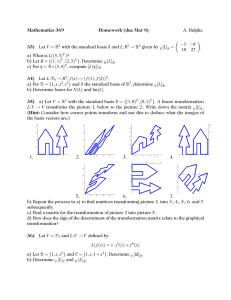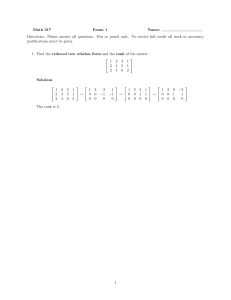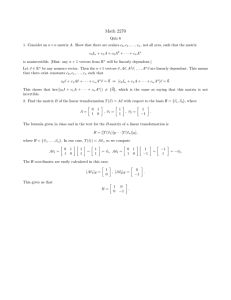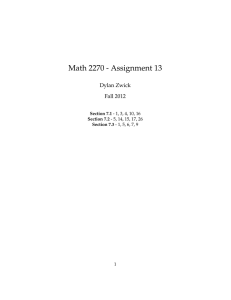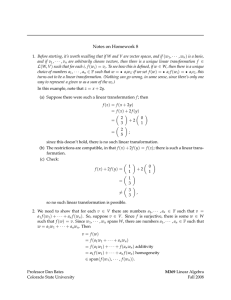Homework 8 = →
advertisement
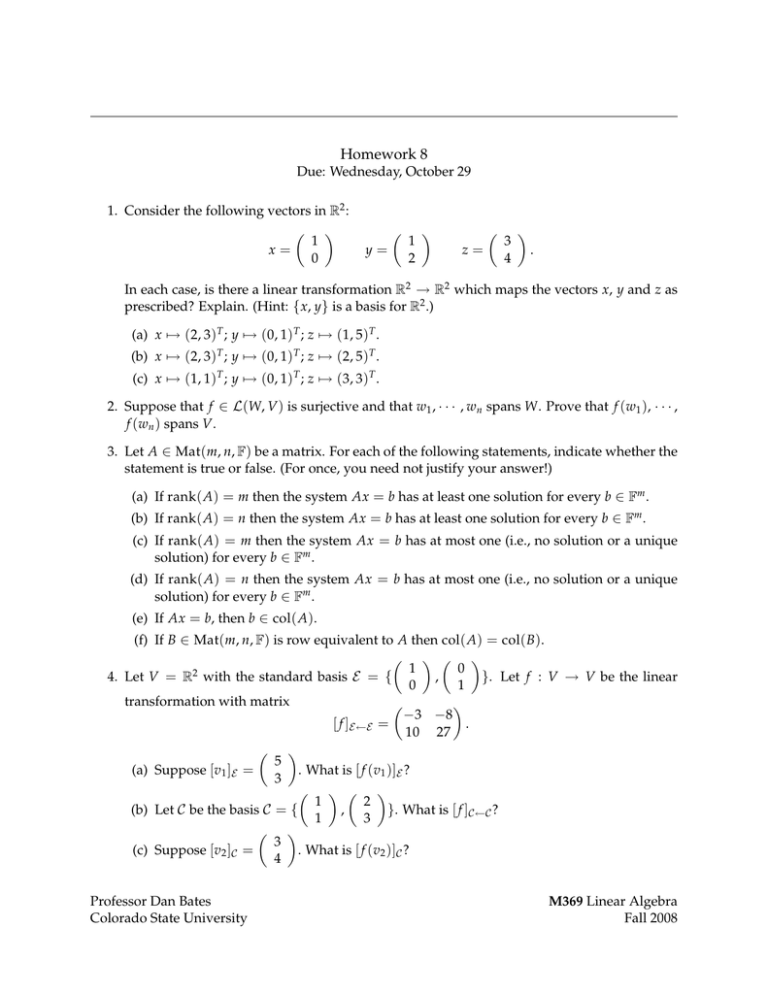
Homework 8
Due: Wednesday, October 29
1. Consider the following vectors in R2 :
1
x=
0
y=
1
2
z=
3
4
.
In each case, is there a linear transformation R2 → R2 which maps the vectors x, y and z as
prescribed? Explain. (Hint: { x, y} is a basis for R2 .)
(a) x 7→ (2, 3)T ; y 7→ (0, 1)T ; z 7→ (1, 5)T .
(b) x 7→ (2, 3)T ; y 7→ (0, 1)T ; z 7→ (2, 5)T .
(c) x 7→ (1, 1)T ; y 7→ (0, 1)T ; z 7→ (3, 3)T .
2. Suppose that f ∈ L(W, V ) is surjective and that w1 , · · · , wn spans W. Prove that f (w1 ), · · · ,
f (wn ) spans V.
3. Let A ∈ Mat(m, n, F) be a matrix. For each of the following statements, indicate whether the
statement is true or false. (For once, you need not justify your answer!)
(a) If rank( A) = m then the system Ax = b has at least one solution for every b ∈ Fm .
(b) If rank( A) = n then the system Ax = b has at least one solution for every b ∈ Fm .
(c) If rank( A) = m then the system Ax = b has at most one (i.e., no solution or a unique
solution) for every b ∈ Fm .
(d) If rank( A) = n then the system Ax = b has at most one (i.e., no solution or a unique
solution) for every b ∈ Fm .
(e) If Ax = b, then b ∈ col( A).
(f) If B ∈ Mat(m, n, F) is row equivalent to A then col( A) = col( B).
1
0
2
4. Let V = R with the standard basis E = {
,
}. Let f : V → V be the linear
0
1
transformation with matrix
−3 −8
[ f ]E ←E =
.
10 27
5
(a) Suppose [v1 ]E =
. What is [ f (v1 )]E ?
3
1
2
(b) Let C be the basis C = {
,
}. What is [ f ]C←C ?
1
3
3
(c) Suppose [v2 ]C =
. What is [ f (v2 )]C ?
4
Professor Dan Bates
Colorado State University
M369 Linear Algebra
Fall 2008
5. Let V =
R2
with the standard basis E = {
1
0
0
,
}, and consider the following
1
pictures:
(1)
(2)
(3)
(4)
(5)
(6)
(7)
(a) A linear transformation f 21 : V → V transforms picture (1) to picture (2). What is
[ f 21 ]E ←E ?
(b) Do the same thing for the rest of the pictures; for each j = 2, · · · , 7, find the matrix of
the linear transformation f j1 which transforms picture (1) to picture (j).
6. Consider the matrix
A=
−12 30
.
−5 13
(a) Confirm that A has eigenvectors (3, 1)T and (2, 1)T .
(b) Find the eigenvalues corresponding to each eigenvector.
(c) What are the geometric and algebraic multiplicities of these eigenvalues?
(d) Write down one vector from each of the eigenspaces of A other than the vectors in part
(a).
(H INT: This problem is just to make sure you know the definitions – there is nothing tricky about it.)
Professor Dan Bates
Colorado State University
M369 Linear Algebra
Fall 2008
